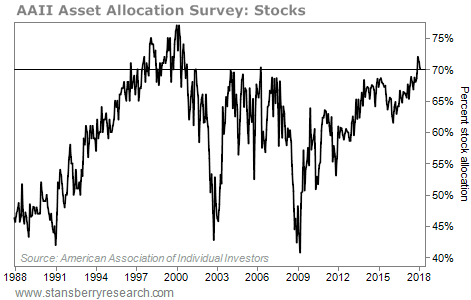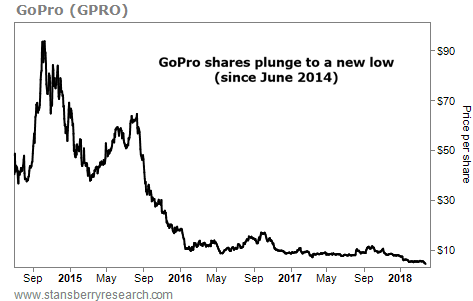| Home | About Us | Resources | Archive | Free Reports | Market Window |
This 'Sign of the Top' Won't Cause a Market CrashBy
Tuesday, March 27, 2018
It's finally happening...
One of the big tell-tale signs of the end of a speculative boom is when individual investors heavily commit to buying, like we saw during the dot-com boom in 1999.
It's not just in stocks, though... It can happen in any potentially speculative asset. For example:
Greed is a powerful thing... It can take over – particularly with individual investors. Greed took over rational thought in bitcoin last December. The cryptocurrency soared to nearly $20,000 before it crashed back down... Today, it trades around $8,000, a 60% fall from that peak.
In short, when individual investors are piling in, the top is often near.
That is, often – but not always...
According to the latest survey from the American Association of Individual Investors (AAII), individual investors have recently had a greater allocation to stocks than at any time since the dot-com boom.
In fact, the recent readings are some of the highest we've seen since the survey began in November 1987.
Stock allocations have soared during this bull market. They went from around 40% at the 2009 bottom to more than 70% right now. Based on this indicator, individual investors are now more bullish than they've been at any time during this boom.
You need to see something important, though.
It's the reason why this "sign of the top" DOES NOT mean stocks are peaking right now...
During the last "Melt Up" in stocks – when the market soared during the dot-com boom – stock allocations first broke above 70% in 1996. That was three-and-a-half years before the ultimate peak. Take a look...
 In 1998, stock allocations hit 75%. That was the year before the final Melt Up phase propelled markets dramatically higher in 1999 and 2000. So, we have two takeaways from this "sign of the top"...
First, individual investors are more bullish than they've been at any other time during this bull market. That looks like a red flag or warning sign to me.
However... that alone doesn't mean the peak is here today.
The last great Melt Up started from similar levels of stock ownership. That tells me that this red flag is simply a marker of where we are now – the beginning of today's Melt Up in stocks. It's not a sign of the end.
Based on history, stocks can still soar dramatically – even from these levels.
Good investing,
Steve
Further Reading:
"I always say that if you really want to succeed as an investor, you must buy what's hated and sell what's loved," Steve says. "This is absolutely correct – almost all of the time." It's the exception to one of his most important rules... Read more here: Today's Record-High Optimism Doesn't Mean You Should Sell.
"It felt like the top," Brett Eversole writes. "The problem as that it wasn't the top." One of the lessons of the last "Melt Up" is that we don't want to call the peak too early... Learn more here: Investors Are 'All In' – But Selling Could Be a Terrible Mistake.
Market NotesANOTHER 'HOT' STOCK FAILURE Today's chart is an important reminder to stay away from "cocktail party" stocks...
If you find yourself at a party where everyone is talking about the same company, it's time to be cautious... See, people take comfort in following the herd. But when everyone you know owns the same stock, it's a sign that no one is left to buy...
GoPro (GPRO) is an excellent example. The company sells wearable video-cameras, primarily for sports enthusiasts. The stock went public in June 2014, and it quickly soared to nearly $94 as investors bought in to the hype. But we warned readers that this trendy stock was in trouble here and here. Last year, GoPro hired JPMorgan Chase (JPM) to help sell the business. But earlier this month, reports surfaced that no one is making any serious offers.
As you can see below, GoPro shares have continued to fall. The stock is now 95% below its old highs, hitting another new low last week. It's yet another reason why investors should avoid "hot" trends and stick to what works...
 |
Recent Articles
|



